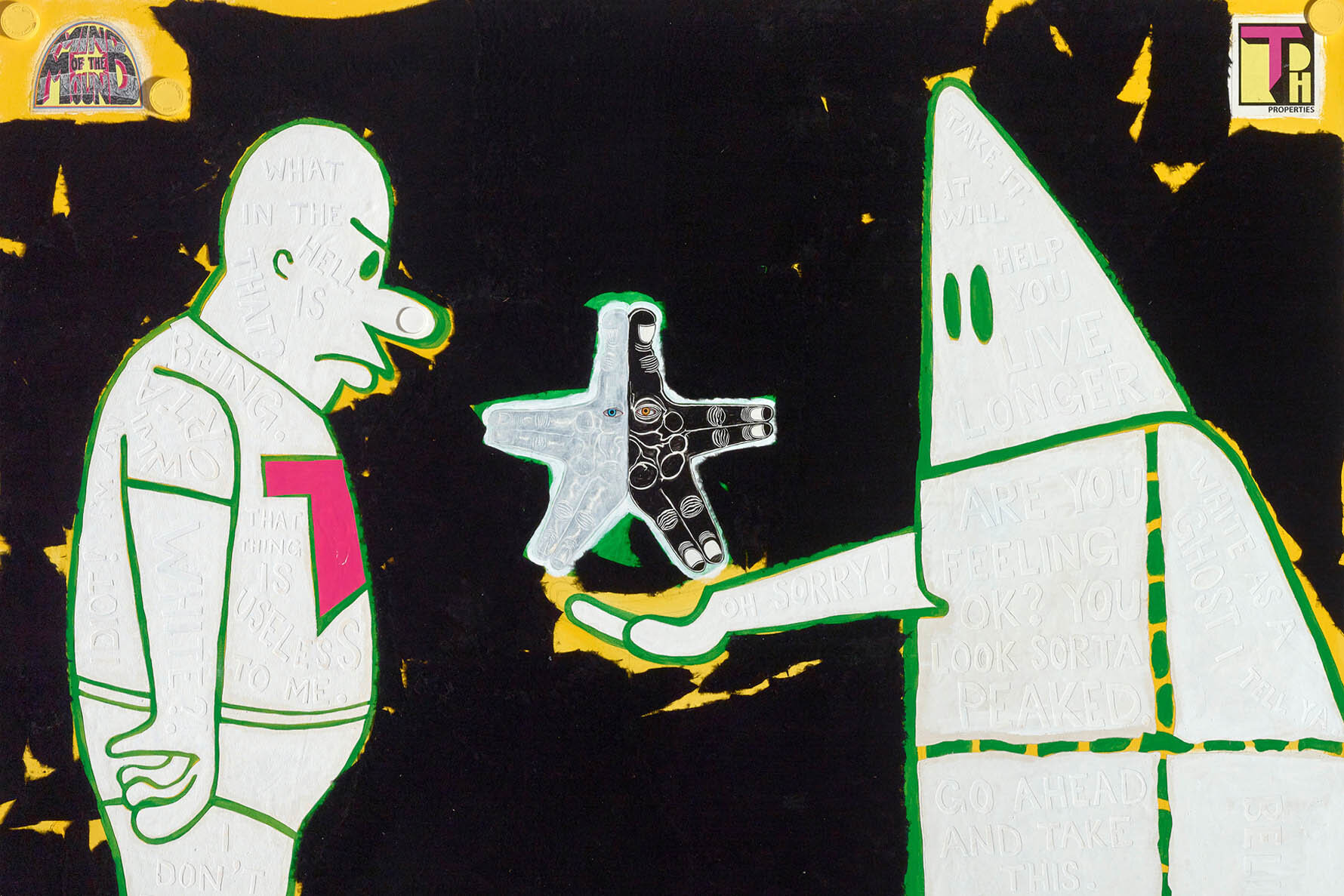Aaron Johnson Discusses His New Crowd Paintings
Installation view, Aaron Johnson: New Paintings at Joshua Liner Gallery. Image courtesy of the gallery.
New York-based artist Aaron Johnson creates raw story-like tableaus, paintings that feature humans and creatures stuck in extreme narratives, and more recently canvases and standalone sculptures built-up with layers of painted socks. His highly-detailed, fantastical aesthetic with jarring colors consistently pushes the limits of decorum. In his latest series of crowd scenes, Johnson takes a new approach, creating amorphous figures using a staining technique similar to what the color field painters used half a century ago. A conversation started at Joshua Liner Gallery in New York City, where his exhibition, “New Paintings” was held from June 7 through July 6, 2018.
Nothing Comes from Nowhere, 2018, acrylic on canvas, 78×66 in. Image courtesy of Joshua Liner Gallery.
Chris Bors: How did these new crowd scene paintings come about? They seem related to your works on paper, but the technique is different.
Aaron Johnson: Groups of figures have been a recurring motif for awhile. In all my work over the years I’m more interested in the figures in the paintings and less interested in the backgrounds or in setting a specific place. I’m interested in the interactions between figures. Take that idea and make it more dense, and every figure gets grounded in another figure, steering the figure-ground relationship to more of a figure-figure-figure relationship. When I make a crowd scene, I’m stacking up figures in a way that fills up most of the canvas. They developed out of my works on paper with tiny figures in clusters. There was a Trump rally piece, a large work on paper in 2017, which shifted my focus toward crowds and the psychological terrain of the crowd.
CB: The colors are mostly earthy, wish some intense bursts of brighter colors. How did the new work affect your palette?
AJ: I’m making an intentional dialogue with color field painting in this series. From Morris Louis to Helen Frankenthaler to Rothko; I love all that stuff. Some of the color sensibility comes from that lineage. Certain bright colors: turquoises, magentas, yellows, bleed into raw canvas with a really seductive luminosity. I’m also into contrasting those radiant color bursts with darker brooding tones, raw umbers, Payne’s grays. I set up psychological tensions by allowing these color energies to clash.
A Cowboy and a Tomcat Walk Into a Bar, 2018, 78 x 66 inches. Image courtesy of Joshua Liner Gallery.
CB: Since you rely on staining and pouring, how do you balance intentionality with chance, and what aspects of your paintings are planned?
AJ: I work on these pieces with a soaking wet canvas set up on the floor. Then, I walk around the canvas with brushes attached to pool cues, painting figures into the canvas. The intention is to paint figures, and the chance element is how those figures will bleed and morph with the fluidity of the paint in ways that I cannot plan or predict.
CB: Because these works hover between abstraction and representation, was your goal to have them more open to interpretation than your previous work?
AJ: Yes. These works have been harder for me to wrap language around, because they are not as involved with specific symbols or narrative elements. I was conscious of what was not welcome in these paintings: burgers, pizza, socks, American flags, Trumps. Those are loaded symbols that I’ve relied on in some of my previous work. In this series I wanted to get into a more enigmatic space, less didactic, less illustrative, more painterly. These works are more about a visual experience than they are about ideas.
The Guests, 2018, acrylic on canvas, 96 84 inches. Image courtesy of Joshua Liner Gallery.
CB: Crowds and group mentality are very topical in our current political climate, but you are also drawing on art history, right?
AJ: We are living in the quagmire of the Anthropocene, for sure. We are living in sociopolitical times where it feels like a battle between forces of evil and forces of light. We see a raw collective conscious played out in berserk social media comment feeds. I think all of that is floating in the atmosphere around the making of these paintings. The light against dark dynamic in the language of color is one channel. Another art historical layer at play in these works is an existential expressionism, in particular Kirchner’s Berlin street scenes, and other influences from Munch to Ensor to Dix. In a more contemporary context, a Twin Peaks worldview is at play in these works, where I’m imagining these scenes as gatherings of figures that emerge through portals; figures in another dimension that parallels ours.
CB: You are quoted in the press release stating that the fluidity of paint has a connection to your subconscious, as if something spiritual manifested from your process. Did you consider Rothko’s idea of an energy source coming from within the work?
AJ: I didn’t think specifically of that Rothko idea, but yes, I am interested in an energy that can emit from a painting, and from color. I like to imagine this painting process as a kind of conjuring, and that these figures manifest themselves, each bringing a certain vibration.
Installation view, Aaron Johnson: New Paintings at Joshua Liner Gallery. Image courtesy of the gallery.










